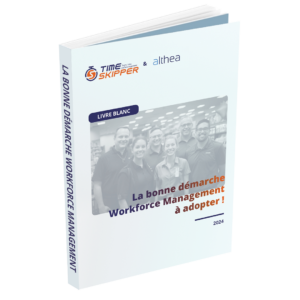exaTurnaround refers to practices aimed at reversing a lousy situation to revitalise activity and safeguard jobs.
Recognised as THE solution for optimising work management in the retail industry, the TimeSkipper platform is a major asset when it comes to restructuring. This is particularly true when the risk of imminent bankruptcy requires a thorough transformation, work methods, and allocating resources. These situations have been particularly frequent over the last twenty months, with certain brands and formats suffering the full impact of the health crisis.
It’s, therefore, only natural that companies should turn to Timeskipper when they need to “do it fast and do it right” to improve their performance fundamentals.
The platform creates a complete and sustainable transformation plan focused on performance. It’s based on three interdependent levers:
1- Observe, listen, and analyse the internal and external contexts,
2- Evaluate business practices,
3- Own changes and manage the transformation plan.
As you can see, conducting your turnaround with Timeskipper is the surest way to succeed. Let’s see how it works!
I/OBSERVE, LISTEN AND ANALYSE THE INTERNAL AND EXTERNAL CONTEXTS
In a company that’s weakened, experiencing strong competitive pressure and a tense social situation, it’s essential to take the time to observe and analyse the situation to understand and measure the dysfunctions. Listening to all stakeholders (employees, middle management, management, social partners, etc.) is essential during this stage. The exercise generates an overall analysis of the situation, making change management much more straightforward.
How can we avoid navigating solely based on what we see and its disastrous consequences?
In this phase, the platform is used as a diagnostic tool to help understand what isn’t working, measure losses, and guide decisions towards a more efficient organisational model. Timeskipper’s differentiating asset lies in its ability to bring together the players involved in the change with an objective approach by integrating the company’s internal and external environment. We mean considering the market concept and management strategy, customer profiles, operational efficiency, and all the upstream processes. These are no more and no less than the levers that must be analysed and on which the company must rely to get back on its feet.
This exercise always highlights dysfunctions that can be solved by the actors of change (the operational staff) and external agents that could impact the company’s performance. And there are many of them! Logistics, procurement, merchandise, HR, IT, etc. The objective is to include them in the thought process and highlight the inconsistencies between departments that lead to poor performance in the points of sale. Their involvement must be productive and go in the same direction as the new company strategy. This is the price to pay for achieving an end-to-end vision, providing qualified recommendations and, ultimately, carrying out the turnaround.
Timeskipper’s expertise reassures companies that are losing momentum and their shareholders. It enables all the players to be involved and to lead the change with relevance and efficiency… and that is what is at stake in a successful turnaround!
II/ASSESSING GOOD BUSINESS PRACTICE
In order to understand the company’s working methods, the evaluation of good operational practices is an essential step. Indeed, improper application of business practices leads more quickly to poor performance and exacerbates an already delicate situation from a profitability and customer satisfaction point of view.
The Timeskipper team relies on its solid expertise to evaluate these practices and share recommendations for improvement. The tool highlights the scheduling and duration of tasks, who is assigned to them and when they should be done. In order to make this approach sustainable, it is necessary to set and monitor targets for the allocation of hours to tasks and individuals. This is also what makes it possible to move from a situation with unoccupied hours to an optimized situation: cut back on overtime, no systematic renewal of temporary fixed-term contracts, no replacement of people on sick leave or retirement, reduction of the workforce if the situation requires it, but also allocation of workloads to employees in a fair and transparent manner. In this sense, the tool helps to see and maintain a well-functioning organisation, through which the success of the turnaround depends. Relevant, isn’t it?
Of course, this expertise was not acquired overnight. Timeskipper’s evaluation method is based on the development of time and task benchmarks, the result of meticulous timing campaigns and operation records, which can go from shelf setting to product category. This is how Timeskipper has produced the time reference systems for most European retailers. An unequivocal guarantee of confidence and objectivity!
III/ Ensuring ownership of changes over time and steering the transformation plan
As we have seen, listening, observation and understanding are the starting point for a successful turnaround. The tool makes it possible to materialise the new work organisation and manage the teams’ activity daily, with schedules and objectives that consider best practices and action plans.
The platform also highlights the impact of failures in upstream processes (procurement, logistics, merchandise, etc.) that can cause value destruction in the shop. This encourages the upstream players to conduct action plans to make the best decisions for the company, such as optimised transport vs shop efficiency. Ultimately, the tool enables the entire value chain to be worked on and steadily start visualising the gains over time. As for the performance indicators, they are used to optimise the company’s end-to-end organisation in a true logic of continuous improvement.
Ultimately, the tool enables the company to make the best and quickest decisions to ensure that the business turns around.
Conclusion
Turning around a company is a colossal challenge that involves different dimensions: economic, financial, capital, human, social and psychological. Therefore, absolute priorities are listening to all the players involved in the transformation, observing good practices to optimise the organisation, and considering the context and environment for good change management. A challenge becomes more complicated when it needs to be carried out quickly!
Through its expertise, Timeskipper provides companies in underperforming situations with the confidence and assurance that they can “get through it”:
- The time spent on understanding the company’s DNA, its context, its way of working, its local and structural specificities, as well as the mastery of good business practices, contributes significantly to the supporting general and operational management,
- Workload calculations and performance indicators make the recommendations obvious, making it easier to get the financial departments on board,
- Listening to the different parties involved and the change management, carried out with skill and relevance, reassures the Human Resources departments.
And suppose the actors of the change (Financial Services, Human Resources and Management) have been on board throughout all stages of this process. In that case, they have the arguments to reassure their shareholders before the latter decide to reinvest in repositioning the offer and adapting the business model.






